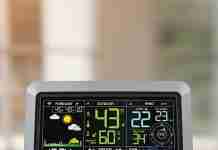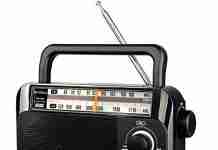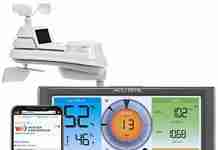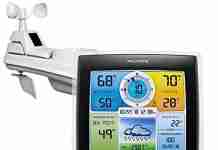Curious about the range of a home weather station? Wonder no more! In this article, we’ll uncover the typical range you can expect from these nifty devices. Whether you’re a weather enthusiast or simply want to plan your day with precision, knowing the reach of your weather station is key. So, let’s embark on a journey of discovery and find out just how far these devices can go in keeping you informed about the ever-changing elements that surround us.
Review contents
Definition of a Home Weather Station
A home weather station is a device that allows individuals to track and monitor weather conditions in and around their home. It consists of various sensors that measure temperature, humidity, wind speed and direction, rainfall, and other atmospheric variables. These sensors are connected to a central console or display unit, where the data is collected and displayed in real-time. Home weather stations provide accurate and up-to-date weather information, allowing users to make informed decisions about outdoor activities, gardening, and home maintenance.
Understanding the Purpose of a Home Weather Station
The purpose of a home weather station is to provide individuals with accurate and localized weather information. While meteorological agencies and websites offer general weather forecasts, they often cover large areas and may not reflect the specific conditions in a particular neighborhood or microclimate. With a home weather station, you have access to real-time data that is specific to your immediate surroundings. This allows you to plan your day accordingly, whether it’s deciding whether to bring an umbrella or adjust your garden watering schedule.
Components of a Home Weather Station
A home weather station typically consists of several components that work together to measure and record weather data. These components include:
- Temperature sensor: Measures the ambient temperature in Celsius or Fahrenheit.
- Humidity sensor: Measures the relative humidity in the air.
- Anemometer: Measures wind speed and provides information on wind direction.
- Rain gauge: Measures the amount of rainfall that has occurred.
- Barometer: Measures atmospheric pressure and helps predict weather changes.
- Display unit: Shows the collected weather data in an easy-to-read format.
These components may be integrated into a single unit or spread across multiple devices, depending on the model and brand of the home weather station.
Types of Home Weather Stations
Home weather stations come in different types, each offering unique features and capabilities. The two main types of home weather stations are basic and smart weather stations.
Basic Home Weather Stations
Basic home weather stations are the most common and affordable option for homeowners. They typically include the essential components mentioned earlier, such as temperature sensors, humidity sensors, anemometers, and display units. Basic weather stations provide accurate and reliable weather data but may lack advanced features like wireless connectivity or smartphone compatibility.
Smart Home Weather Stations
Smart home weather stations are more advanced and offer additional features and connectivity options. They often have Wi-Fi or Bluetooth capabilities, allowing you to connect the weather station to your smartphone, tablet, or computer. Smart weather stations use dedicated apps or software to provide real-time weather updates, historical data, and personalized weather alerts. Some smart weather stations can even integrate with other smart home devices, providing a seamless and integrated smart home experience.
Range of Home Weather Stations
When considering a home weather station, it’s important to understand the range of the device. The range refers to the maximum distance at which the home weather station can accurately transmit data between its sensors and the display unit.
Indoor Range
The indoor range of a home weather station refers to how far away the sensors can be from the display unit while still maintaining a reliable connection. The typical indoor range is around 100 to 300 feet, although this can vary depending on the model and brand. It’s important to consider the layout of your home and the location you plan to place the display unit to ensure it can receive data from all the sensors.
Outdoor Range
The outdoor range of a home weather station refers to how far away the display unit can be from the sensors while still receiving accurate data. The typical outdoor range is also around 100 to 300 feet, but it can be affected by factors such as interference, obstacles, and transmission power.
Factors Affecting the Range
Several factors can affect the range of a home weather station. It’s important to consider these factors when determining the ideal range for your needs.
Interference
Interference from other electronic devices, nearby power lines, or wireless networks can disrupt the transmission of data between the sensors and the display unit. To minimize interference, it’s important to choose a home weather station that operates on a frequency free from interference and avoid placing it near other electronic devices.
Obstacles and Terrain
Physical obstacles such as walls, trees, or buildings can block or weaken the signal between the sensors and the display unit. The range of the home weather station may be reduced if there are obstacles between the sensors and the display unit. Consider the layout of your property and the potential obstacles that might affect the signal strength when deciding on the range you need.
Transmission Power
The transmission power of the home weather station’s sensors and display unit can also affect the range. Higher transmission power typically results in a longer range but may consume more power as well. It’s important to find a balance between range and battery life, especially if you prefer a wireless or battery-powered home weather station.
Determining the Ideal Range for Your Needs
To determine the ideal range for your needs, consider the following factors for both indoor and outdoor applications.
Considerations for Indoor Range
For indoor applications, consider the size of your home and the placement of the display unit. Measure the distance between the display unit and the farthest point where you would like to place a sensor. If your home has multiple floors or thick walls, you may need a home weather station with a longer indoor range to ensure all sensors can transmit data reliably.
Considerations for Outdoor Range
For outdoor applications, consider the layout of your property and the location of the sensors. Measure the distance between where you plan to place the sensors and where you want to position the display unit. Take into account any potential obstacles or interference that might affect the range. If your property is large or has significant obstructions, you may need a home weather station with an extended outdoor range to ensure accurate data collection.
Extending the Range of a Home Weather Station
If you find that the range of your home weather station is not sufficient for your needs, there are a couple of options for extending the range.
Using Signal Repeaters
Signal repeaters are devices that can amplify and extend the range of a home weather station. These devices receive the signals from the weather station’s sensors and retransmits them at increased power, allowing for longer transmission distances. Signal repeaters can help overcome obstacles and increase the range of a home weather station, especially in outdoor applications.
Positioning the Weather Station
Another way to extend the range of a home weather station is to strategically position the sensors and display unit. Placing the display unit in a central location and avoiding physical obstacles can help improve signal reception. Similarly, positioning the sensors in open areas without obstructions can enhance the range and reliability of data transmission. Regularly checking and optimizing the positioning of the weather station can ensure accurate and consistent readings.
Popular Home Weather Station Brands
There are several popular brands known for producing high-quality home weather stations. While each brand offers its unique features, the following are two well-regarded brands in the market.
Brand 1: Features and Range
Brand 1 is known for its user-friendly interfaces and accurate weather measurements. Their home weather stations offer a range of up to 300 feet, making them suitable for most residential applications. They provide real-time weather updates, historical data analysis, and customizable alerts. Brand 1 also offers seamless integration with smartphones and other smart home devices, adding convenience and functionality to their weather stations.
Brand 2: Features and Range
Brand 2 specializes in advanced weather monitoring technology. Their home weather stations have a range of up to 500 feet, making them ideal for larger properties or areas with obstacles. In addition to standard weather measurements, Brand 2’s stations offer advanced features such as UV index tracking, lightning detection, and solar radiation monitoring. These stations are often favored by weather enthusiasts and hobbyists who require in-depth weather data.
Cost Considerations
When considering a home weather station, it’s important to weigh the range against the price. Typically, home weather stations with longer ranges tend to be more expensive due to their advanced features and higher transmission power.
Range vs. Price
If you only require weather data for a small area or have budget constraints, a home weather station with a shorter range may be sufficient. These stations are generally more affordable and offer accurate data within a limited range. However, if you require accurate weather data for larger areas or need to transmit data through obstacles, investing in a home weather station with a longer range may be worth the higher price.
Additional Features and Cost
Aside from range, the cost of a home weather station can also be influenced by additional features such as smartphone connectivity, data logging, or integration with other smart home devices. It’s important to assess your needs and prioritize the features that are most relevant to you. Consider whether the added functionality justifies the additional cost and whether it enhances the overall value and utility of the home weather station.
Benefits of Having a Home Weather Station with a Wide Range
Investing in a home weather station with a wide range can offer several benefits, including:
Accurate Readings
A home weather station with a wide range ensures that data is collected and transmitted accurately, even in challenging environments. By eliminating or reducing interference, obstacles, and limitations, a wide range allows for more reliable and precise weather measurements. Accurate readings enable users to make informed decisions based on real-time localized data.
Enhanced Data Collection and Analysis
A home weather station with a wide range facilitates comprehensive data collection, providing more robust information for analysis and forecasting. With a wider range, you can capture weather patterns and trends across a larger area, contributing to a more detailed understanding of your local climate. Advanced features and greater range can also enable the collection of specialized data, such as solar radiation or lightning strikes, enhancing the depth and scope of weather analysis.
Conclusion
A home weather station is a valuable tool for anyone interested in monitoring and understanding their local weather conditions. Determining the ideal range for your needs involves considering factors such as indoor and outdoor requirements, interference, and terrain. Extending the range can be achieved through signal repeaters and strategic positioning of sensors and display units. Popular home weather station brands offer a range of features and prices to suit different preferences and budgets. While a wider range may increase the cost, it also provides more accurate readings and enhanced data collection capabilities. By understanding the purpose and components of a home weather station, individuals can select the perfect device to improve their weather monitoring experience and make more informed decisions in their daily lives.



































